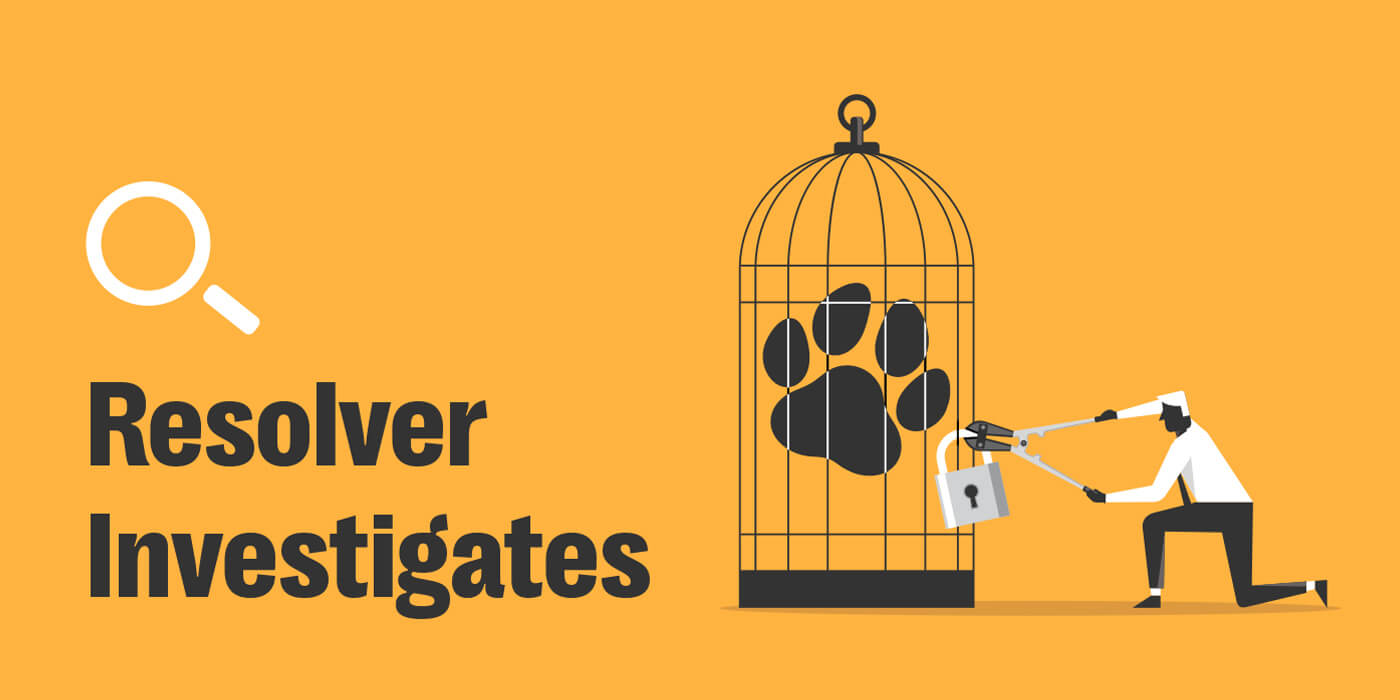While platforms and enforcement authorities continue to strengthen their efforts, illegal wildlife traffickers are finding new ways to adapt and evade. Resolver’s Human Intelligence Team has observed that these networks of criminals are increasingly agile — moving across social networks, e-commerce sites and private messaging apps, employing tactics such as coded language, targeted hashtags, and signposted content to reduce the risk of detection. This activity is particularly visible in parts of Asia, including Thailand, the Philippines and Vietnam, though the impact extends worldwide.
Social media is now one of the fastest-growing gateways for the illegal sale of endangered wildlife. Despite global agreements like CITES (Convention on International Trade in Endangered Species of Wild Fauna and Flora), designed to prevent trade that threatens species survival, traffickers are exploiting platforms to market and distribute illicit products at scale.
The illegal trafficking of animals not only poses a risk to increased endangerment of some species, but also threatens local biodiversity and increases the risks of spreading zoonotic diseases. Such activity also poses a significant challenge for online platforms, mainly as individuals and groups engaging in the illegal trafficking of animals actively and persistently attempt to circumnavigate existing policies and enforcement strategies. This requires the continuous evolution of platform responses and policy reviewals to tackle this pervasive crime.
For platforms, the message is clear: traffickers are adapting quickly, and continued innovation in policies and enforcement approaches will be key to closing emerging gaps.
Illegal wildlife trafficking on social media constitutes a growing crisis
The illegal online commerce of wildlife on social media platforms has exploded in recent years. According to the CITES 2025 report, between August and October 2024, monitoring by the Global Monitoring System (GMS) revealed a sharp rise in online advertisements for illegal wildlife trade (IWT) across Brazil, South Africa, and Thailand. The total number of detected ads reached 1,741 for 34 target species, an increase of 265% compared to the previous three-month period.
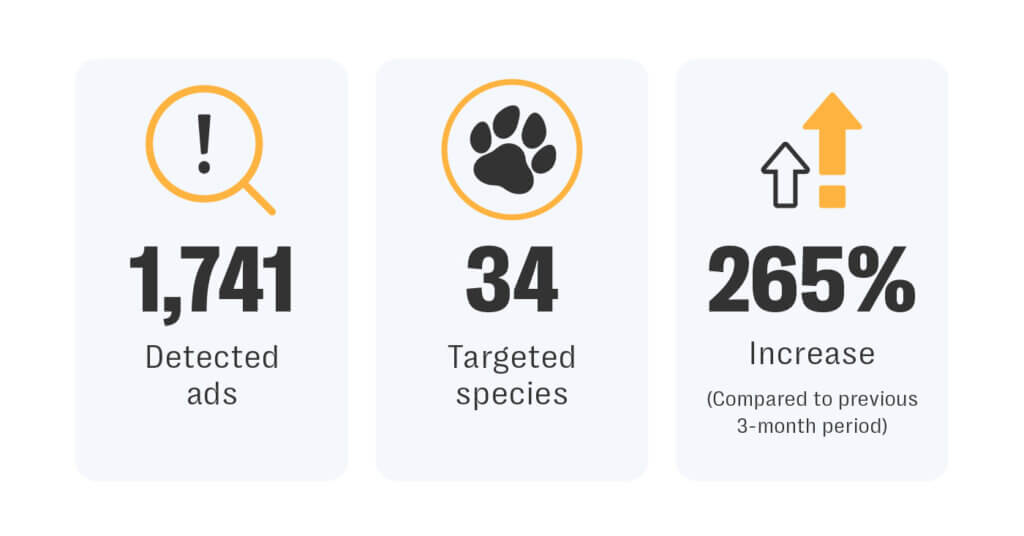
This surge was largely driven by the launch of structured monitoring in Thailand, which alone accounted for over three-quarters of the total detections. Brazil and South Africa contributed 12% and 11% respectively. In 2015, The majority of these animals were protected under CITES Appendix I, a series of rules and policy regulations designed to ensure the maximum possible protection of endangered species.
The geography of illegal wildlife trafficking
Southeast Asia, which includes countries like Thailand, the Philippines, and Vietnam, is a region of high human and animal trafficking. These countries are typically both points of origin and points of destination for trafficked animals. Meanwhile, India and Indonesia are major exporters of endangered animals, while some areas of Europe, North America, and the Middle East typically serve as the primary destinations of such animals.
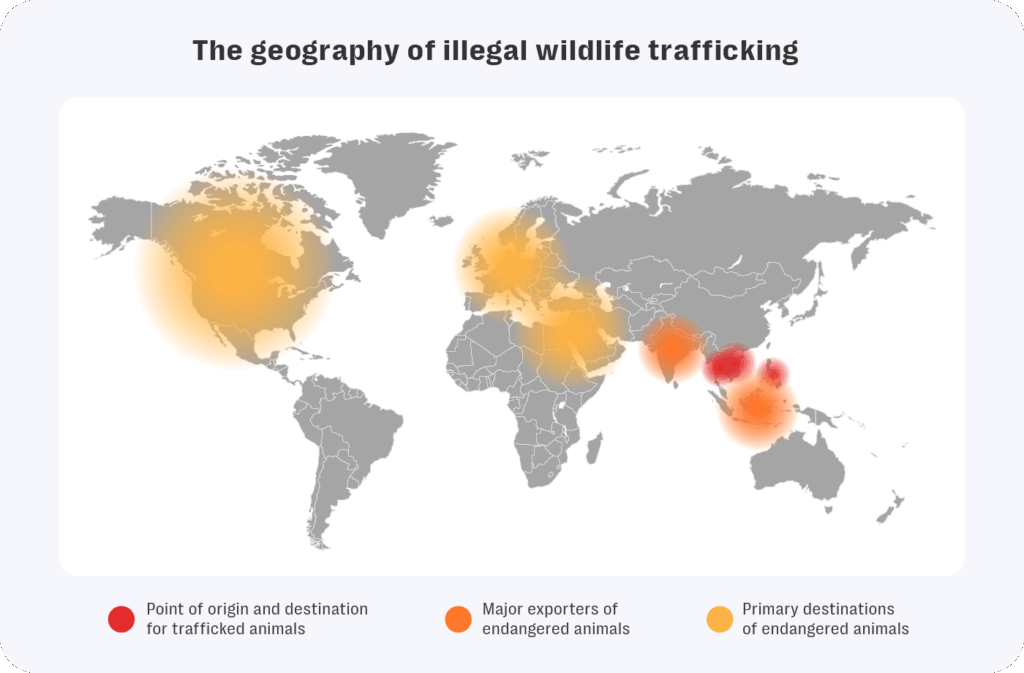
Besides Southeast Asia, Africa also represents a hotspot for animal trafficking, particularly for wildlife like elephants, rhinos, and pangolins. However, traffickers continue to exploit the global connectivity of the online ecosystem – using its reach and speed to connect buyers and sellers across timezones and borders.
The global illegal wildlife trade ranks as the fourth most lucrative criminal enterprise, surpassed only by the trafficking of arms, drugs, and people. Valued at an estimated $23 billion annually. In 2023, TRAFFIC reported that EU authorities have recorded close to 5,200 seizures related to wildlife trafficking, involving more than one million individual items including upwards of 600,000 live animals and 10,000 live plants. Four countries: Germany, France, the Netherlands, and Spain, were responsible for nearly three-quarters of all reported seizures within the EU.
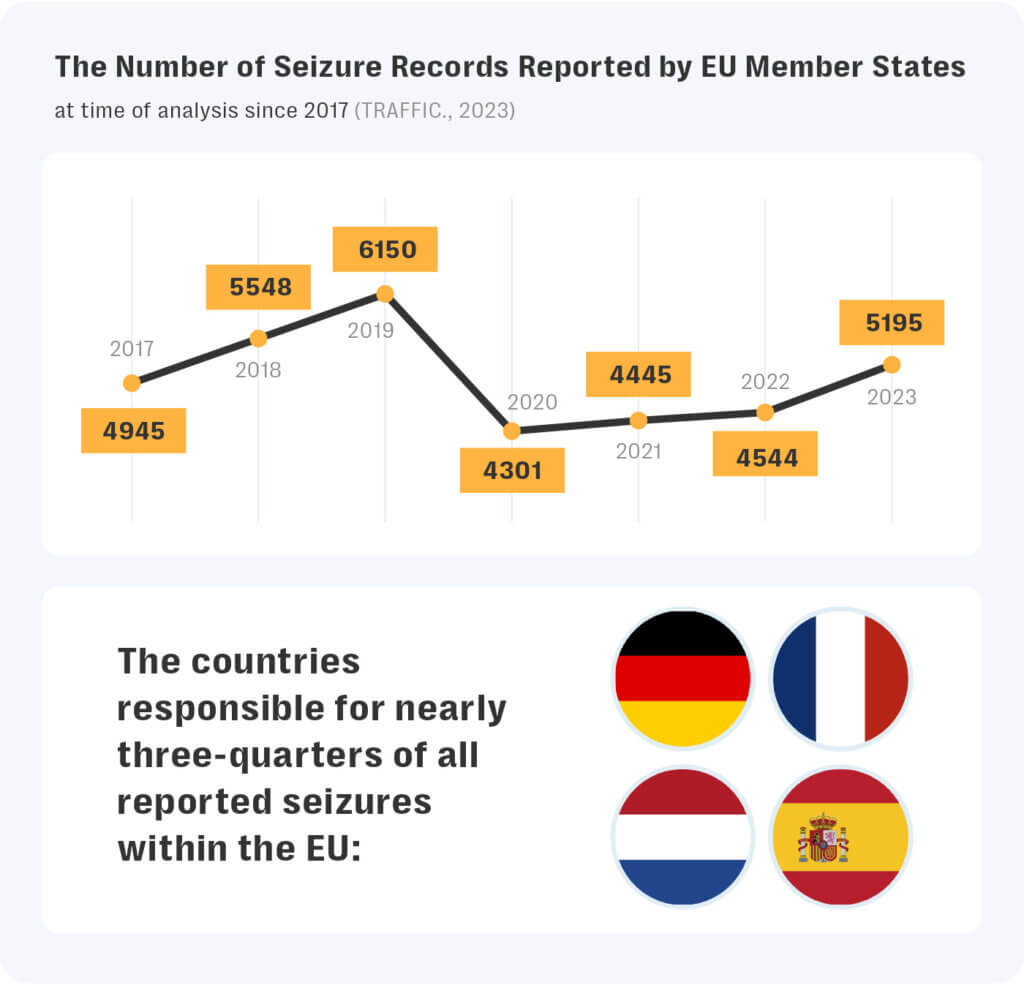
While this figure marks an increase from the approximately 4,550 cases reported in 2022, it remains below the peak of 6,150 recorded in 2019. However, the number of cases is increasing year on year.
The trafficking of wildlife, including endangered species, is frequently orchestrated by the same organized crime groups and leaves a devastating impact, eradicating animal species and severely affecting communities around the world.
A global marketplace for endangered species: what’s on sale?
The majority of the species most commonly sold in illegal wildlife trade include those listed under CITES Appendix I, which includes species that are critically endangered and under the threat of extinction. These species are often sold for exorbitant sums, with traffickers seeking profits from the sale of exotic pets, traditional medicine, and exotic animal parts – activity that has increasingly surfaced online.
Some of the most commonly found species being sold online include:
- Indian Roofed Turtle
- Gray Parrots
- Palm Cockatoos
- Pancake Tortoises
- Batik Arowana
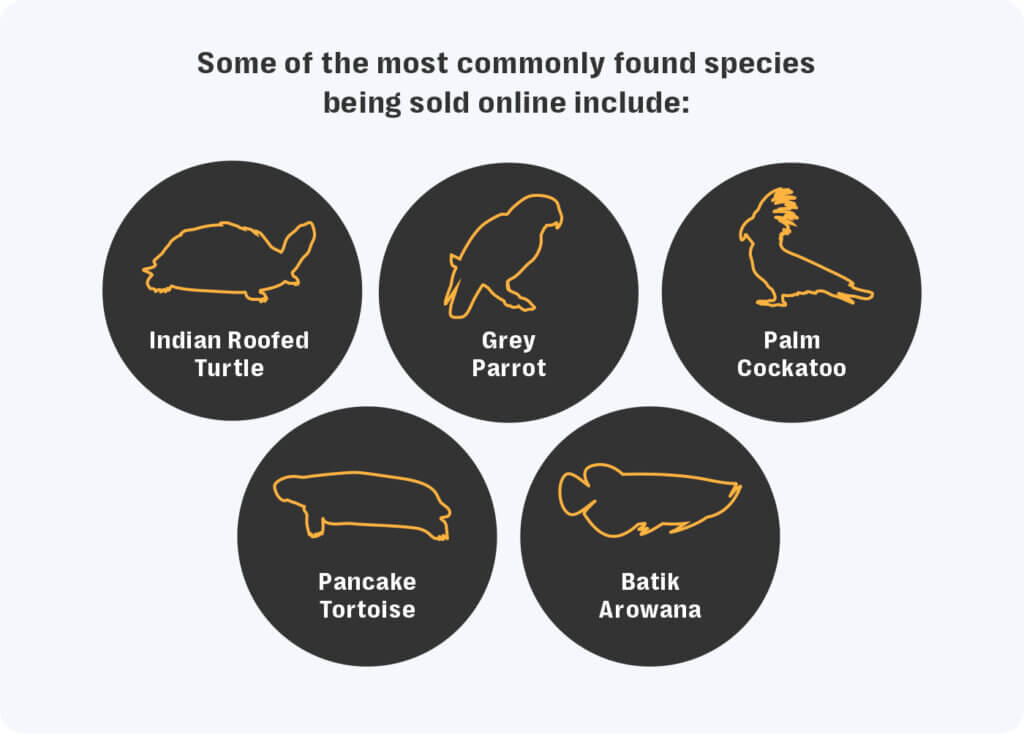
These species are also often promoted online by these bad actors, using pictures or videos featuring the animals in a way to make them attractive to buyers.
The overlap between illegal wildlife trafficking and other transnational crimes
Although the illegal trade in endangered species may seem separate from other forms of crime, there is a close association between animal trafficking and human trafficking. Oftentimes, traffickers involved in the wildlife trade are also involved in the illegal trafficking of humans, particularly where both traffickings are processed on a large scale.
These networks of criminals are often transnational, with operations spanning borders and making use of online platforms in facilitating illegal transactions. Research by the Wildlife Justice Commission (WJC) and UNODC consistently highlights these convergences, noting that wildlife crime is increasingly intertwined with other serious and organised crimes, including drug trafficking, fraud, corruption, and money laundering.
In some cases, traffickers exploit vulnerable populations, including minors, by forcing them into illegal wildlife poaching or smuggling. This is more prevalent where there is weak law enforcement and poverty forces individuals to engage in criminal activities. For example, traffickers will either pay an individual to capture endangered species on their behalf, or force them to smuggle wildlife across international borders, under duress.
The overlap between illegal animal and human trafficking makes enforcement more complex by introducing multiple layers of criminal activity, each with its own complex dynamics and challenges for law enforcement. Firstly, it means that the same criminal networks are often involved in both illicit trades, making them more resilient, financially robust, and harder to dismantle. They leverage the same illicit routes, corrupt officials, and money laundering channels for both human and animal trafficking. Secondly, it highlights the severe human cost of wildlife crime, as vulnerable individuals are exploited and forced into dangerous and illegal activities, which then feeds into a cycle of poverty and criminality.
Additionally, across the dark web the sale of endangered species appears on general and multi-purpose illicit marketplaces rather than specialised wildlife markets. These are large, anonymized online markets where a wide range of illegal goods and services are offered, including drugs, weapons, stolen data, and wildlife products.
While online trafficking also appears on social media platforms and e-commerce sites, the scale and accessibility of those services, combined with the ability for bad actors to “hide in plain sight” by disguising activities, creates opportunities that traffickers exploit.
How wildlife traffickers evade platform enforcement
One of the primary challenges in detecting illegal wildlife trade on social media is the employment of coded messages and secret signposts to remain undetected. These coded language and signifiers are deliberately crafted by bad actors to circumvent automated risk detection filters and blend into high-volume user activity, making it harder for social platforms to detect and enforce such content.
According to Resolver analysis of wildlife traffickers operating across mainstream and dark web platforms between 2024 and 2025, some of the most commonly employed tactics, techniques and behaviors exhibited by such groups include:
- Signposting and coded language: The most commonly employed techniques by trafficker networks include using specific terms, hashtags and forms of videos (such as unboxing videos) to conceal their illegal activities. Other traffickers also put contact details into the metadata or headers of their social media accounts, off-siting would-be buyers to other encrypted or less heavily regulated platforms, such as messaging applications or specialty marketplaces to complete the transactions.
- Use of multiple platforms: Traffickers exploit a diverse array of platforms to engage in illegal wildlife trafficking online. Although large social media sites might be more heavily defended with mature T&S operations, trafficker networks frequently transfer operations to alt-tech social media sites with fewer rules, or encrypted messaging apps where clandestine transactions can more effectively occur.
- Exploiting video content: Illegal wildlife traffickers often attempt to disguise their illegal activity as harmless content such as the “unboxing” of animals. While such content may appear innocuous at first glance, they conceal the fact the animals being unboxed are often also being offered for sale. In other instances, traffickers impersonate social media influencers attempting to educate the public about caring for exotic or endangered species. Similarly, while such content may appear informative, it also includes subtle signposting such as providing the traffickers contact details which are intended to facilitate off-platform transactions for the sale of the animals featured.
- Off-siting buyers to third-party websites: Creators use content descriptions, tags, viewer comment interactions and video titles to divert probable buyers to other websites or encrypted websites where the sale can be made more discreetly. Off-sitting in such a manner makes it more difficult for law enforcement authorities to pinpoint the offenders.
- Using crypto currencies to facilitate payments: In an effort to conceal their activities and avoid the traditional banking system, traffickers now turn to cryptocurrencies as a means of payment. Cryptocurrencies are distinguished by a degree of anonymity, and are exploited by illicit actors to evade and circumvent the financial controls that typically apply to traditional money transfers.
- Blending legal and illegal operations: Some traffickers attempt to mask their illegal activities by also operating legal businesses dealing in rare materials, traditional medicine components, or exotic pets that likely have legal counterparts. This tactic allows those engaging in illegal wildlife trafficking to exploit their parallel legal trade to launder illicit goods. More sophisticated tactics used by such actors also includes mixing permits for legally sourced species with illegally acquired ones or mis-representing wild-caught animals as captive bred.
The use of such tactics creates difficulties for enforcement agencies when attempting to distinguish between illegal trade and legal commerce.
How Resolver helps platforms combat illegal wildlife trafficking networks
Illegal trafficking represents an urgent crisis that requires international, multi-stakeholder collaboration between social platforms, wildlife conservation bodies, anti-human trafficking units, international law enforcement and intelligence agencies to effectively combat.
We must also tackle the social and economic inequalities and systematic failings in the detection and disruption of human trafficking and the ability for traffickers to facilitate sales through online platforms. Without a holistic approach that equally seeks to tackle the proliferation of illegal activities as a viable income for lower socio-economic backgrounds, and the gaps in detection and disruption by law enforcement agencies, there will always be challenges to the reduction of wildlife trafficking.
At Resolver, our team of experts actively work in partnership with media platforms to address these challenges. As part of our Trust and Safety Intelligence, we keep partners apprised of emerging trends and coded language used by such traffickers. These insights are used by our partners to refine their detection algorithms, policies, and risk mitigation strategies.
Additionally, we also collaborate with organizations like the Zoological Society of London to pool expertise, share intelligence, and collaborate towards developing comprehensive and effective solutions for identifying and disrupting illegal wildlife trade online. We believe that by uniting our efforts, we can significantly disrupt organised networks engaging in wildlife trafficking and reduce this illegal activity.
To learn how Resolver supports platforms in identifying and disrupting illegal wildlife trafficking networks, explore our Trust & Safety Intelligence solutions.

